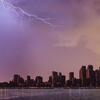This is a weather phenomenon that almost everyone has experienced at one point or another. Some pass by in mere moments while others can last for hours! In this video, NOAA SciJinks explores the science of hurricanes. NOAA SciJinks, created by the National Oceanic and Atmospheric Administration, provides a library of videos, activities, and articles about weather and Earth science!
Lightning Basics
A bolt of lightning and a crack of thunder can make anyone jump! Learn about lightning with the National Oceanic and Atmospheric Administration (NOAA)! Lightning is a giant spark of electricity in the atmosphere between clouds, the air, or the ground. In the early stages of development, air acts as an insulator between the positive and negative charges in the cloud and between the cloud and the ground. When the opposite charges build up enough, this insulating capacity of the air breaks down and there is a rapid discharge of electricity that we know as lightning.
The Science of Lightning
You probably already know “When Thunder Roars, Go Indoors” and “See A Flash, Dash Inside!” But do you know what causes lightning and thunder in the first place? Explore more with the National Weather Service.
Outdoor Lightning Safety
Each year in the United States thunderstorms produce 20 to 25 million lightning flashes that strike the ground. Lightning kills at least 20 people, and injures hundreds more, often in devastating and permanent ways. Learn some important lightning safety tips from the National Weather Service!
Why Are There Clouds?
Thunderstorms have to start somewhere. Our atmosphere creates clouds all the time, some as high as 20 kilometers above sea level. This video by MinuteEarth explores how and why clouds form. Video recommended by the Department of Earth and Environmental Science in Temple’s College of Science and Technology and used as a teaching tool in the class Disasters: Geology vs. Hollywood.
The Science of Hail
Chunks of ice that fall from the sky can cause serious damage to property, and injuries to people and animals. But how does hail form? The National Weather Service explores the science of hail.

